
In an effort to address these considerations, the University of North Carolina at Chapel Hill (UNC) has been utilizing a “real time” or hourly pricing structure for procurement of electrical power for the past several years. This pricing structure has resulted in wide variations in the cost of electrical energy and has required significant flexibility in the operation of thermal utility systems to minimize costs. This article presents the methodology used to develop a program to model the predicted energy cost of various chilled water production alternatives and the efforts to incorporate operational flexibility into these systems. It also discusses the operation of the cogeneration system and various methods of chilled water production.
Existing Systems at UNC Chapel Hill
The University of North Carolina uses cogeneration to provide its primary utilities: steam, electricity, and chilled water. The systems include the following major equipment:Cogeneration Facility
500,000 pph CFB coal/gas/oil-fired boilers
400,000 pph gas/oil fired boilers
1-28 MW steam turbine generator
Central Chilled Water System
7,500 tons of single-stage steam absorption chillers
15,700 tons of electric centrifugal chillers
1,200 tons of screw compressor chillers
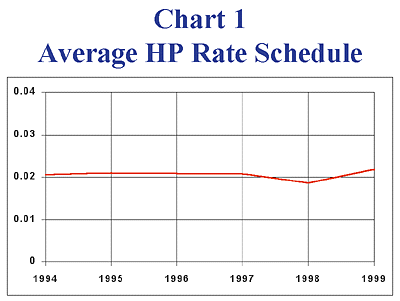
Rate Schedules, Old and New
The original design of the cogeneration system at UNC is based on a study completed in 1984 when the Parallel Generation (PG) rate schedule was in effect. This schedule designated particular hours of each day as on-peak, and a demand penalty was applied to all new demand that occurred within this time period. The demand penalty had a 12-month ratchet and was a dominant feature of the rate schedule.The system utilizes a steam turbine generator which is a dual extraction (150 psig and 40 to 55 psig), with condensing capability up to 10 MW. The 1,275 psig steam generated in the two coal fired boilers passes through the turbine and is extracted at 150 psig to serve plant turbine-driven equipment and to meet campus process loads. The steam extracted at 40 to 50 psig serves heating load and low-pressure steam absorption chillers.
The rate schedule was changed to the Optional Power Service, Time of Use (OPT) plus Purchased Power (PP) when the generator was placed into operation. All generated power was sold on the PP rate, and all power required by the university was purchased on the OPT rate. On the PP rate, the university was paid about $.0371 per kWh for on-peak power and only $.0255 per kWh for off peak power. The on-peak period was 7 a.m. to 11 p.m. weekdays. All other weekday and weekend hours were off peak. In the summer, the steam absorption chillers were base loaded. The generator was ramped up each day during the demand period with the condenser. Although this operation was simple to implement and understand, it forced daily cycles on the turbine and the boilers.
The present Hourly Pricing for Incremental Load (HP) electrical rate structure is a “real time” schedule and has been in place since 1998. The hourly price for the upcoming day is given to UNC at 3:00 p.m. the day before the pricing is in effect. UNC adjusts its operation accordingly to minimize overall utility costs. Figure 1 indicates the average cost of electricity under the hourly pricing schedule for the past six years. Although this appears very attractive to a user, this price is only used to calculate the energy component of the total hourly rate. The rate schedule has three major components: fixed and tax charges, baseline charge, and the hourly pricing charges.
In 1999 the fixed component made up 9.3% of the total cost and included extra facilities charges and taxes. The baseline charge made up 80.2% of the total annual electrical cost in 1999. The purpose of this charge was to establish a revenue neutral baseline from the 12 months billing data prior to going on the HP rate.
This charge is the same as buying a block of 199,815,600 kWh for $.04615 each.
The hourly pricing charge makes up 10.5% of the annual electrical cost in 1999. This charge uses the hourly price and has three components: incremental demand, reduced load–new load, and an incentive charge.
The incremental demand charge is $.26 per each kW above 61,515 kW and has yet to be enacted.
The second part of the hourly pricing charge is for reduced load – new load. This charge is calculated hourly for all kWh above or below the baseline load of 22,810 kW. If the load is below the baseline, the electric bill is reduced. If the load is above the baseline, the electric bill increases. The hourly price used to calculate this charge could vary widely. Over the past six years this price has been as low as $.01 per kWh and as high as $.35 per kWh.
This hourly price has two components. The energy charge is the hourly charge equal to expected marginal production costs including fuel, line losses, and other directly related costs. The rationing charge is determined on an hourly basis and consists of a generation component and a transmission component. The generation component comes into play any hour the reserves are low. The transmission components have an effect any hour when the system demand is expected to be 90% of the peak demand.
The final part of the hourly pricing charge is the incentive charge. This $.005/kWh charge for overhead and profit is only applied to monthly net new load. Net new load is calculated by summing the hourly new loads (above 22,810 kW) and reduced loads (below 22,810). There is no charge applied if the net new load is zero or negative.
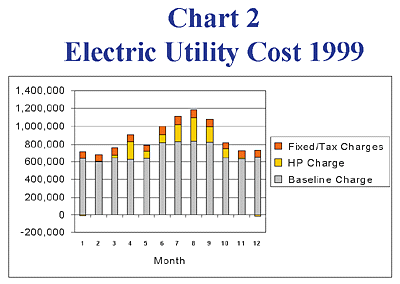
A breakdown of the yearly electrical costs for 1999 is shown in Figure 2.
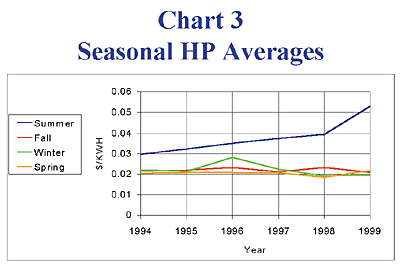
Trends in Hourly Pricing
Although the average costs under the hourly pricing structure appear to be relatively constant from year to year, this is somewhat misleading. The rates should be examined and analyzed on a seasonal basis. Figure 3 illustrates the average hourly pricing on a seasonal basis for the past six years.
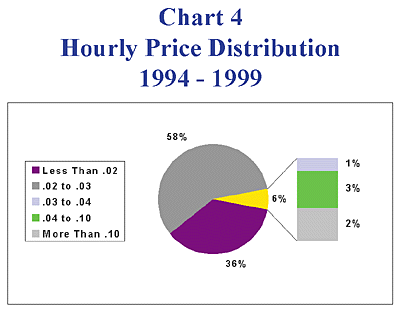
Optimizing Under the Hourly Price Schedule
Careful coordination between the operation of the electric generation and campus cooling system requires a detailed analysis of the hourly price occurrence at various rates. Figure 4 shows a breakdown of the hourly price rates. As you can see, the rate is less than $0.03/kWh for about 94% of the time, and above $0.10/kWh only 2% of the time.Based on the marginal cost of fuel (coal, limestone, ash removal), water, and electricity, UNC has determined that it can self-generate power utilizing the surface condenser on the steam turbine generator at a cost of about $0.03/kWh. Therefore, it makes sense to operate in this mode anytime the hourly pricing schedule dictates. Beyond that point, the system can utilize the low-pressure extraction steam and single-stage absorption chillers to increase generation up to 28 MW.
Since there currently exists a mix of 7,500 tons of single-stage absorption chillers and approximately 17,000 tons of electric chillers, there is significant flexibility on chilled water system operation relative to the use of extraction steam. It has been determined that the breakeven cost for absorption chiller operation is $0.035/ kWh when compared to the least efficient electrical chiller in the system, which would normally be the next available chiller for operation. When hourly pricing is above the absorption breakeven cost, electric generation is maximized through the use of 40 to 55 psig extraction steam and the single-stage absorption chillers. When costs are low, the use of purchased power should be maximized and the electric chillers are used extensively.
The current system arrangement and mode of operation is ideal during periods of high hourly pricing. The use of the extraction steam for absorption cooling allows the turbine generator to be loaded to its full capacity of 28 MW. One of the concerns is how to deal with the inefficient single-stage absorption chillers during low rate periods. In the past, the absorption chillers were always base-loaded, which resulted in excess operating costs under the hourly pricing schedule.
The latest mode of operation minimizes base loading the absorption chillers to the greatest extent possible during these low rate periods. However, low rates do not always occur at low loads, so many times the operating costs suffer due to the necessity to operate absorption chillers just to meet the load, as shown in Figure 4.
Although the overall absorption chiller operation provides significant savings, the current system cannot take full advantage of these low rate periods. Since the hourly price is below $0.03/kWh for 94% of the time, this can become costly. However, if the average hourly price continues to increase in the summer months, the absorption units will become more and more cost effective.
It is clear that additional emphasis must be placed on improving the optimization of the absorption chillers without sacrificing their reliability and expected life. Another important issue is the balance between chilled water produced with steam and other production options. This issue must be carefully considered and addressed in future expansions.
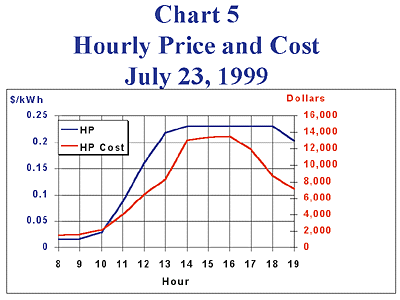
Reliability and Hourly Pricing
The reliability of all utility systems is extremely important to successfully optimizing under the HP rate schedule because much of the financial risk is transferred from the utility to the customer. This includes the boilers, the turbine generator, substation gear, and chilled water systems. Reliability has been an extremely important factor in the design and operation of UNC’s utility systems, and very few outages have occurred.On July 23, 1999 a crane working on a road-widening project contacted the 100 KV transmission lines that serve the cogeneration facility. There was a short power outage in which the loss of power resulted in the shutdown of the primary air fans on the boilers and the subsequent trip of the turbine generator. Although this outage is not typical of the cogeneration system operation, it is an excellent example of the potential financial impact of failures under an hourly pricing rate schedule. Effective control of electrical costs under the hourly price schedule is highly dependent upon reliable operation of the system equipment to minimize usage during high rate periods. If this type of system reliability cannot be achieved, the hourly price schedule will likely result in significant additional costs over more conventional pricing systems.
Due to this outage, the purchased power went from 30 MW to nearly 60 MW. This outage coincided with high hourly prices, about $.23/kWh, as shown on Figure 5. This chart also shows the cost per hour for the operation during this period. The hourly cost went from around $6,000 to about $13,500.
This is a short outage but it indicates the consequences of failures at critical times.
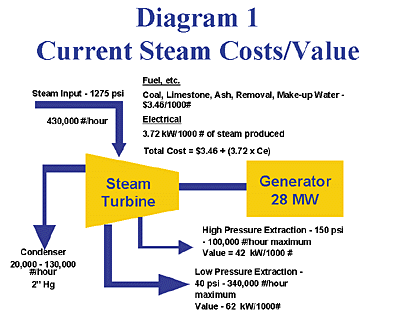
System Analysis – Data and Options
As the utility needs of the system continue to increase, refinements and additions to the systems need to be made. The electrical distribution system and steam system have recently been expanded to meet campus demands for the next 5 to 10 years. The chilled water system, however, will require significant additional capacity to meet the projected load growth in this time period. Since the chilled water system is an integral part of the overall campus cogeneration system, the chiller types selected will significantly affect the overall system operation and efficiency. Therefore, a detailed analysis of the various alternatives was performed in order to implement the most cost-effective solution.The analysis was complicated by the complex hourly pricing structure and the relative relationship of the electrical energy cost, campus cooling load, and availability of excess steam from the cogeneration system. Fortunately, UNC had excellent historical data that quantified these parameters on an hourly basis for the past several years. The following data was readily available for the analysis on an hour-by-hour basis:
- Hourly electrical price;
- Output of steam turbine generator;
- Total steam production;
- High-pressure steam extraction rate;
- Low-pressure steam extraction rate;
- Total campus cooling load;
- Cooling load met by absorption chillers on a plant-by-plant basis;
- Cooling load met by electric chillers on a plant-by-plant basis.
Several alternative chiller types were investigated and performance data was developed for each. The following chiller types were analyzed:
- Single-stage low-pressure absorption;
- Steam turbine centrifugal;
- Electric centrifugal;
- Electric centrifugal with thermal storage.
Performance curves were developed for each of the chiller types indicating chiller energy costs relative to the hourly electrical pricing. These curves were based on the consumption data previously noted, plus the cost of steam at various extraction pressures as developed by UNC. Figure 6 depicts the operation of the existing cogeneration system.

- Low-pressure extraction steam produces 62 kW/1,000 lbs of steam extracted (Cogenv);
- High-pressure extraction steam produces 42 KW/1,000 lbs of steam extracted (Cogenv);
- Marginal cost of steam production = $3.46/1,000 lbs of steam (coal-fired);
- Marginal cost of steam production = $ 6.38/1,000 lbs of steam (NG-fired);
- Marginal electrical usage (Me) steam production = 3.72 kW/1,000 lbs of steam;
- Ce = Hourly electrical price.
Therefore, the cost of operation for the steam-driven chillers, with coal as the fuel-source, was calculated as follows.
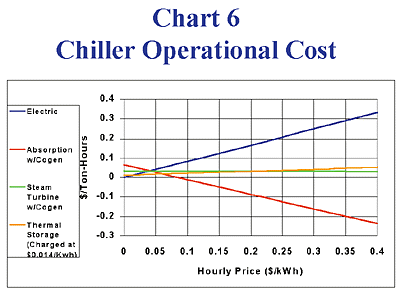

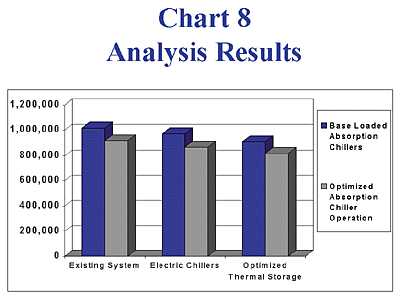
Simulation Model/Analysis Tool
In an effort to analyze this complex system, a customized analysis and operational model was developed. The program utilized the historical utility pricing and load data, as well as the equipment performance data previously noted. The model determined the most cost-effective method/sequence of operation for the various scenarios, as well as an annual energy cost for each.Three options were modeled: the base case or existing condition utilizing 7,500 tons of low-pressure steam absorption chillers and 16,900 tons of electric centrifugal chillers; two new 4,000-ton electric chillers; and, finally, a 40,000 ton-hr thermal storage system that could reduce the peak load by approximately 4,000 to 5,000 tons. The steam turbine-driven chiller options were not considered due to space constraints within the existing plant, as well as the lack of need to use additional high-pressure extraction steam. Each option was modeled two-ways: base loading the absorption chillers and optimizing the chiller loading. The results of the analysis (marginal costs) are noted in Figure 9.
It is interesting to note that base loading the absorption chillers has a significant effect on the energy cost of the system. The absorption chillers provide an economical method of producing chilled water during periods of high hourly pricing, but are not cost effective during the relatively large number of hours during low hourly pricing. Based on the results of this analysis, the following conclusions were drawn:
- Operate the steam turbine generator only when the hourly electrical price dictates (>$.025 to $.03 cents/ kWh);
- Operate the low pressure absorption chillers only when the hourly electrical price is high (>$.035 to $.04 cents/ kWh);
- Maintain a good blend of electric and steam-driven chillers for optimum flexibility;
- Utilize thermal storage to take full advantage of low hourly electrical pricing.
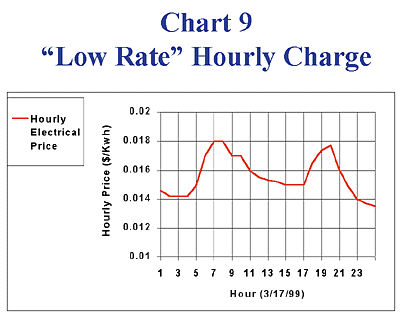
Conclusions
The use of hourly electrical pricing affords many opportunities to reduce utility costs. The key to cost reduction is the ability to reduce purchased power during periods of high pricing, but to purchase significant amounts of power during the low-cost periods. As demonstrated, this can be effectively accomplished with a cogeneration system and thermal storage system that works in conjunction with the campus chilled water system. Since the campus cooling systems account for a significant portion of the total electrical consumption and demand, they must be an integral part of the cogeneration system.Due to the fact that the hourly pricing structures are very complex and complicated, a customized evaluation and operational model is essential for maximizing system efficiency. This model can be used not only to simulate system operation to determine the best mix of chillers, but it can also be used as an operational tool to determine optimum control strategies. This tool becomes even more critical when the chilled water system incorporates thermal storage, as minor changes in operation can drastically affect system performance. The quantity of steam-driven and electrically driven chilled-water equipment must be carefully selected to take advantage of low rates at nights and periods of low demands, yet be able to minimize electrical usage during high-rate periods.
UNC has effectively accomplished this with a mix of high efficiency electric centrifugal chillers and single-stage absorption chillers that integrate with the cogeneration system. However, care must be taken to allow for sufficient flexibility in this mix, so as to not adversely affect energy costs as the hourly electrical rate changes. The use of thermal storage allows a greater flexibility in the periods of time in which the electric chillers can be utilized, thus reducing overall energy costs.
